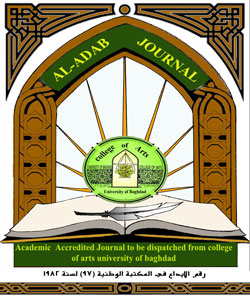The impact of language contact in a bilingual translation class
DOI:
https://doi.org/10.31973/aj.v0i129.584Keywords:
bilingualism, language contact, translators, linguistic differences, learnersAbstract
This effort focuses exclusively on the realization of the phenomenon of language contact and the impact it has on the language behavior of users. Each two languages, or more, by one way or another may get into a contact situation when they are alternately used by the same person. Among the situations where both languages would be exposed to contact that of the translation class covered by this study. The present effort highlights the example of French and Arabic languages used alternatively by university level translator-learners, specifically by third year students.
After having shown the aspects of bilingualism related to the subject, and following a corpus elaborated to trace the source of the problem, being the realization of the contact of languages in the class concerned, we notice that the phenomenon is actually realized and that negative impacts are seen in the production of the translator-students as to the translating activity. In this respect, all the gaps in the pedagogical situation are identified and effective solutions are therefore proposed in order to cope with the linguistic problems which hinder any progress made by the translator-students. It is a matter of establishing measures to avoid, or at least reduce, the negative impact resulting from the meeting of two different linguistic systems, which affects the performance of translators in the process of learning.
Downloads
References
AL-MUSAWI Jaafar, Formation et pratique des enseignants de traduction français-arabe/arabe-français dans les universités irakiennes, thèse de doctorat soutenue à l’Université Franche Comté, 2016
CALVET Louis-Jean, La sociolinguistique, Paris, Presses Universitaires de France, 1993
CASTELLOTTI Véronique, La langue maternelle en classe de langue étrangère, Paris, CLE International, 2001
LADMIRAL Jean-René, Traduire : théorèmes pour la traduction, Paris, Payot, 1979
LAVAULT Elisabeth, Fonctions de la traduction en didactique des langues, Paris, Didier Erudition, 1998
LEDERER Marianne, La traduction d’aujourd’hui ; le modèle interprétatif, Caen, Lettres Modernes Minard, 2006
MOUNIN Georges, Les problèmes théoriques de la traduction, Paris, tel Gallimard, 1963
NEYRENEUF Michel, La problématique des interférences langagières entre l’arabe et le français, document proposé par le Lycée Français de Jérusalem et validé par M. Michel NEYRENEUF, 2010
ROBERT Jean-Pierre, Dictionnaire pratique de didactique du FLE, Paris, Ophrys, 2008
TITONE Renzo, Le bilinguisme précoce, Bruxelles, Dessart, 1972
Downloads
Published
Issue
Section
License
Copyright and Licensing:
For all articles published in Al-Adab journal, copyright is retained by the authors. Articles are licensed under an open access Creative Commons CC BY 4.0 license, meaning that anyone may download and read the paper for free. In addition, the article may be reused and quoted provided that the original published version is cited. These conditions allow for maximum use and exposure of the work.
Reproducing Published Material from other Publishers: It is absolutely essential that authors obtain permission to reproduce any published material (figures, schemes, tables or any extract of a text) which does not fall into the public domain, or for which they do not hold the copyright. Permission should be requested by the authors from the copyrightholder (usually the Publisher, please refer to the imprint of the individual publications to identify the copyrightholder).
Permission is required for: Your own works published by other Publishers and for which you did not retain copyright.
Substantial extracts from anyones' works or a series of works.
Use of Tables, Graphs, Charts, Schemes and Artworks if they are unaltered or slightly modified.
Photographs for which you do not hold copyright.
Permission is not required for: Reconstruction of your own table with data already published elsewhere. Please notice that in this case you must cite the source of the data in the form of either "Data from..." or "Adapted from...".
Reasonably short quotes are considered fair use and therefore do not require permission.
Graphs, Charts, Schemes and Artworks that are completely redrawn by the authors and significantly changed beyond recognition do not require permission.
Obtaining Permission
In order to avoid unnecessary delays in the publication process, you should start obtaining permissions as early as possible. If in any doubt about the copyright, apply for permission. Al-Adab Journal cannot publish material from other publications without permission.
The copyright holder may give you instructions on the form of acknowledgement to be followed; otherwise follow the style: "Reproduced with permission from [author], [book/journal title]; published by [publisher], [year].' at the end of the caption of the Table, Figure or Scheme.












